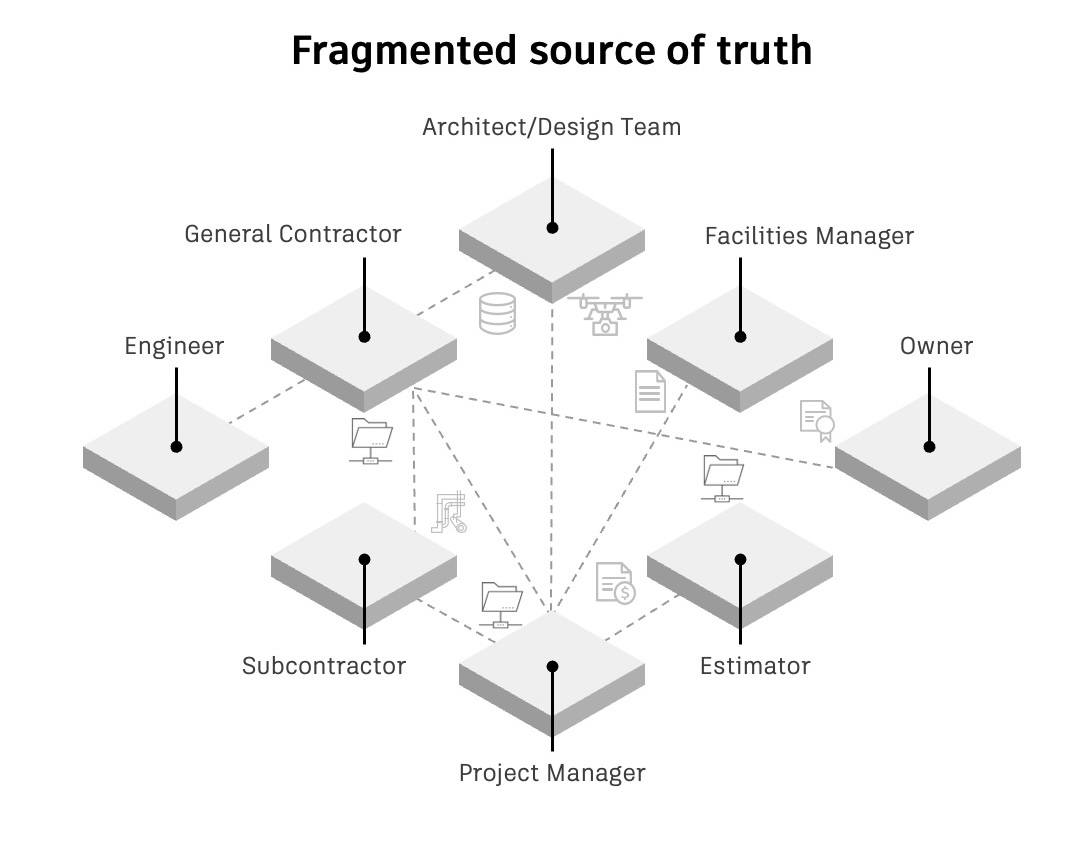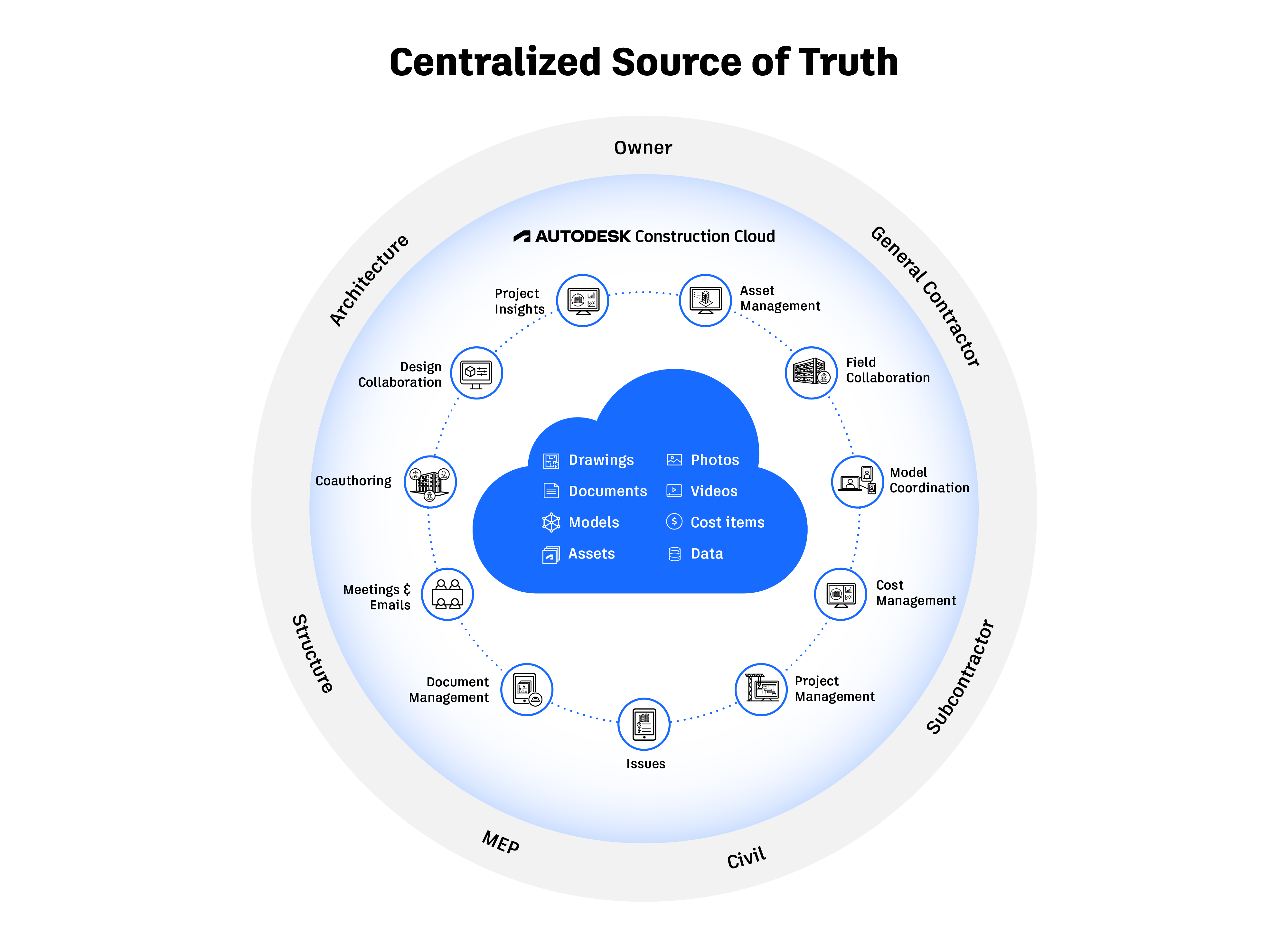It’s no secret that the AEC industry is getting more complex. Projects are more fragmented, transient and bespoke than ever before — creating massive efficiency issues that are pushing projects over schedule and over budget. According to KPMG, half of all construction projects underperform their objectives, and McKinsey reports that 98% of megaprojects face cost overruns or delays. This is a worrisome trend that needs to be reversed.
Digital project delivery is the key to mitigating these risks. Putting the right information in the right person’s hands at the right moment enables collaboration across teams, reduces errors and rework and keeps processes moving throughout the project lifecycle. Consider the design-build delivery method –– it breaks down contractual challenges often found in traditional project delivery models, transforming disjointed teams into connected units and encouraging seamless information sharing. When combined with the design-build delivery method, digital project execution allows teams to entirely reconsider their approach to efficiency, work quality and building lifecycle costs. It enables design-build teams to fine-tune how they handle people, processes and technology in the most effective manner for their projects.
Yet, achieving digital project delivery depends on design-build teams’ capability to ensure data is accessible and flexible across complex workflows. To maximize the benefit derived from digital project delivery and design-build, all project stakeholders need to merge project information into a unified data environment in the cloud.
Complexity Rules the Day

Today’s design/bid/build projects are remarkably disjointed. Each project incorporates a variety of stakeholders, such as contractors, subcontractors, designers, consultants, suppliers and service providers who operate within their own distinct sectors, delivering their contributions before moving on to subsequent tasks. If project delivery were a single, isolated task, this strategy would suffice. However, in actuality, it is an iterative process fraught with unforeseen modifications along its course.
The other problem is that, with a few exceptions, most AEC projects are unique, and the bespoke nature of the AEC industry causes data related to design and construction to often be duplicated, compartmentalized and inaccessible due to fragmented sources of truth. Every project and every task requires on-the-ground expertise and decision-making, preventing the level of automation that has streamlined other industries. Other industries have solved these operational problems by creating valuable business insights through data.
But the AEC industry doesn’t have a data problem. In fact, we’re drowning in data. What we have is a data management and accessibility problem. Vital information, ranging from 3D concept models to facility and IoT information, is spread out in various applications, databases, emails, text messages and other point solutions — making it hard for stakeholders to gain a clear, complete picture of the problem at hand.
A Push to Harness the Power of Data
Digital project delivery provides a work environment free of silos that enables more interaction with team members and less time to deliver projects than traditional ways of working. Design-build projects using digital project delivery offer the potential to be designed and built with less material, in less time and for less money. However, digital project delivery can only be enabled with a common data environment that allows various stakeholders to access the information they need when they need it. Armed with these valuable insights, design-build teams can collaborate freely across silos, make changes in real time and ensure that everyone has visibility into all aspects of the project.
Better data management and accessibility give project leaders better insights into project status and allow them to anticipate issues that crop up in real time. Various teams can work closely together in tandem without stepping on each other’s toes — improving coordination, collaboration and communication. This eliminates errors due to change management issues and reduces the amount of work that must be redone to accommodate those changes.
The result? Projects stay on schedule and on budget and deliver better outcomes.

Not All Common Data Environments Are Created Equal
Unfortunately, it’s not as simple as snapping your fingers and declaring that all project data is consolidated in a single location where all stakeholders can access it. Design-build teams need the right data management infrastructure in place to enable digital project delivery.
Here are three things to keep in mind when implementing a common data environment for your design-build project:
- Don’t get bogged down with file types: Previous digital transformation efforts in the AEC industry have focused on file integration, allowing users to import and export varying file types into other applications and point solutions. This is a band-aid approach with several shortfalls. For example, what happens when a change is made in one file but not the other? Sure, firms can exchange files again, but that requires manually checking for inconsistencies — a tedious and error-prone task. Models and designs also get flattened during the import/export process, stripping out much of the metadata and other data necessary to put the files in the proper context. Instead, design-build teams should focus on sharing the granular data encoded within these files. Breaking them down into raw data allows organizations to make changes to data points in a central repository once, and all files that rely on that piece of data are automatically updated. It doesn’t matter if you’re working in one application over another. Focusing on data, not files, allows you to connect the digital thread across the project lifecycle whatever digital tools are being used across teams.
- Focus on accessibility, not storage: Storing data in a central repository accelerates and improves decision-making, but you also must make sure it is consumable and accessible to all stakeholders. Building Information Modeling (BIM) helps design-build teams create and manage all information for a built asset in a single, consolidated data environment. Powered by advanced analytics, BIM in the cloud ensures that all stakeholders have relevant, accurate information of an asset across the entire project lifecycle — from planning and design to construction and operations — wherever they log in. It’s important to make sure your common data environment leverages the power of real-time collaboration and transforms construction data into business insights. Capabilities such as daily task lists and automatic clash detection, a feature that makes it easy to catch, clear and resolve inconsistencies before they lead to delays, are important. This allows project leaders and other stakeholders to get a bird’s eye view of the entire design-build project by tracking processes from start to finish.
- Improve workload capacity and capture business insights: Coupled with growing project demands and complexity, labor shortages and retiring workforce are problems facing AEC companies. Setting up workflows around a common data environment allows all design-build team members to access the right information at the right time, streamlining processes throughout the project lifecycle. This real-time design collaboration leads to more transparency and less rework while maximizing efficiencies and avoiding the loss of important information and insights.
Breaking Down Silos
Complexity is an unfortunate reality that, if not addressed appropriately, could severely impact innovation. This would be disastrous across the AEC industry, making it difficult to keep projects on time and on budget. Organizations need a better way to harness project data in a way that enables collaboration across fragmented, siloed teams. Digital project delivery relies on data accessibility through a common data environment. It’s important that this data infrastructure goes beyond just file types, focuses on accessibility over storage and accurately and efficiently captures legacy expertise and intellectual property to streamline operations and better improve project outcomes in the future. Choosing the right common data environment with granular access to data is crucial to enabling this cross-team collaboration and communication.

Ali Atabey is a technical solutions executivAli Atabey is a Technical Solutions Executive at Autodesk devoted to solving his customers’ business challenges through an innovative and transformative approach. He specializes in BIM, generative design, and construction cloud. Prior to joining Autodesk, Ali worked as a technology leader for over 10 years. His roles included BIM manager, and instructor for computational design and digital fabrication. Ali contributed to the delivery of over a million square feet of space in mixed-use, high-rise developments as well as healthcare and higher-ed projects.
